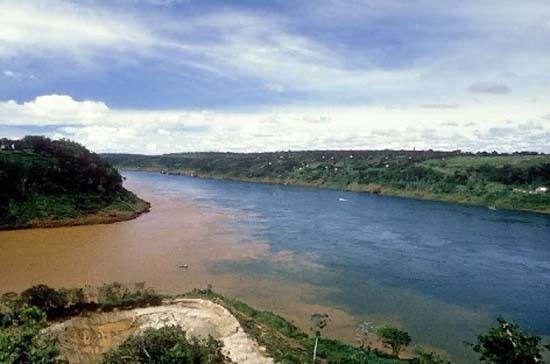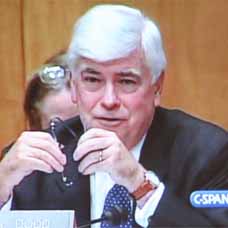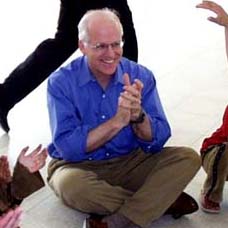
"Ecologist and microbiologist Garrett Hardin made famous the term "tragedy of the commons," which he explained by presenting the scenario of a pasture that is used by several individual ranchers. When one rancher puts a cow on the pasture to graze, the cow represents a financial benefit to that rancher alone, but the grazing has an impact on a resource that is shared by the entire population of ranchers. Each rancher has a financial incentive to add cows to the common pasture until the pasture is overgrazed and cows begin to starve and die. Hardin argued that unfettered access to a common resource leads to unsustainable use of the resource and that this is the crux of most problems of environmental degradation, as individual self-interest is not tempered with forward-thinking policy."
Paraguay PCV Nicholas Bayard writes: Valuing Nature in Environmental Education
Valuing Nature in Environmental Education
Jul 1, 2006
Green Teacher
Activities for introducing concepts of environmental economics
TRADITIONAL ECONOMIC THOUGHT presumes that economic growth and increased prosperity are one and the same. In fact, gross domestic product (GDP), the standard measurement of economic growth (and therefore "prosperity," according to traditional economists), is simply the sum of consumer and government spending and investment, minus the national deficit. This equation posits that military conflict, rainforest destruction, and massive oil spills all lead to increased prosperity because they boost spending and thereby create profits for individuals.
Environmental economics is a field of thought that expands this vision of prosperity beyond the GDP to include sustainable use of resources, protection of endangered species and wild lands, and human health and well-being. It includes these components by "internalizing" economic factors that traditional economists "externalize" from their analysis of the market, such as people's willingness to pay to protect a natural area, or the devaluation of a land base's future productivity due to unsustainable agricultural practices. Recognizing that human well-being is inextricably linked to the health of the environment, environmental economists put forth a worldview that is even more human-centered than that of traditional economists, in that it takes into account more facets of human well-being.
In The Future of Life, E.G. Wilson writes that "the juggernaut [of technology-based capitalism] will very soon either chew up what remains of the living world, or it will be redirected to save it."1 Environmental economics can be used as a tool to redirect industrialism toward constructive ends. Discussions of traditional versus environmental economics help students understand a broad spectrum of human interests in the environment and expose the shallowness of the debate between self-styled "economists" and "environmentalists." We might ask, what environmentalist does not play a part in industrial capitalism, and what economist does not derive livelihood from natural resources? The spectrum of human interests in the environment ranges from bottom-line assessments of potential for resource exploitation to intrinsic arguments in defense of nature.
Puzzling through the complexity of these value systems lays a foundation for a complete environmental education and enriches prior knowledge of the relationship between humans and nature. Through the activities outlined below, students will become familiar with some of the language and processes of a society propelled by money, and examine the ways in which they themselves value nature.
Activity 1: The Tragedy of the Commons
Ecologist and microbiologist Garrett Hardin made famous the term "tragedy of the commons," which he explained by presenting the scenario of a pasture that is used by several individual ranchers. When one rancher puts a cow on the pasture to graze, the cow represents a financial benefit to that rancher alone, but the grazing has an impact on a resource that is shared by the entire population of ranchers. Each rancher has a financial incentive to add cows to the common pasture until the pasture is overgrazed and cows begin to starve and die. Hardin argued that unfettered access to a common resource leads to unsustainable use of the resource and that this is the crux of most problems of environmental degradation, as individual self-interest is not tempered with forward-thinking policy.2
The following activity, which has been successful with younger students, demonstrates the tragedy of the commons and leads nicely into discussion about possible solutions. In the scenario, students play the role of ranchers who raise magical creatures called "flibbertigibbets." The flibbertigibbets graze in a common field on mushrooms called "frags." Without restraints placed on the number of animals each rancher can raise, the creatures soon overgraze the resource. The goal of the activity is to demonstrate the catastrophes (both environmental and economic) that can arise when individuals pursue their own economic self-interest without regard for natural cycles and limits and without controls to mitigate their impact on the environment.
Ironically, this is the very system on which capitalism is predicated: free markets and competition in the pursuit of individual self-interest.
In discussion, the activity can be used as a metaphor for a range of "tragedies of the commons," including air pollution, over- fishing, and land development. The activity can take place indoors or outdoors and can include almost any number of students.
Materials
* Card stock or heavy paper for making flibbertigibbet and frag cards. For each student, you will need approximately 15 of each card.
* Blackboard or large paper for charting the results after each round of the game
Procedure
1. Prepare 15 flibbertigibbet cards and 15 frag cards for each student, using the illustrations here as the masters, or drawing your own and photocopying them. If desired, substitute a shrub or other plant for the "frag" mushrooms.
2. Give students the following scenario:
You are a rancher in the land of Zuzubu. You raise flibbertigibbets, hoofed animals that produce magical nectar that flows from their horns. People in Zuzubu pay about $10,000 for each animal's annual production of flibbertigibbet nectar because it cures sickness and tastes great as an after-dinner snack. You need about $50,000 a year to live comfortably in Zuzubu, but should try to make as much money as you can because the cost of living is going up. Flibbertigibbets rely on the mushrooms of a certain species of fungus named Fragilus zuzubulum. The mushrooms, called "frags "for short, are found in a common field that all flibbertigibbet ranchers use.
Flibbertigibbets must eat two frags every year to survive and they must eat three to reproduce. They can produce only one offspring per year.
3. Give each student 3 flibbertigibbets to start, and scatter about 15 frags per student around the room.
4. Explain that each one-minute round of the game represents the annual "harvest" of Fragilus zuzubulum. During the round, students should gather as many frags as they can. They can pick up only one frag at a time, and before reaching down for another they must count four seconds out loud on a watch or clock (to allow their flibbertigibbets to eat) and then put the frag in a pocket. Students who count too fast or pick up more than one frag at a time receive a five- or ten-second time out.
5. After the round, have the students line up and turn in the frags that they have gathered. In exchange for their frags, students either receive additional flibbertigibbets (offspring) or are required to give up flibbertigibbets (due to death by starvation). In some cases, students have choices. For example, if a student started the round with four flibbertigibbets and collected nine frags, all four of the flibbertigibbets could survive and one of them could reproduce (i.e., three would eat two frags and one would eat three frags). In exchange for the nine frags, the student would receive one new flibbertigibbet, for a total of five.
However, if the student is clever and decides to sacrifice one flibbertigibbet, the remaining three flibbertigibbets will have enough frags to reproduce and the student will end up with a total of six.
Note that students may find themselves with more frags than necessary for their three flibbertigibbets to reproduce in the first year, as flibbertigibbets can produce a maximum of one offspring per year. This represents a waste of the resource.
6. Each flibbertigibbet owned at the end of a round represents $10,000 in earnings for the year. After each round, chart or graph each student's earnings (see example "Annual Income" chart).
7. Play five to eight rounds of the game. After the first round, scatter some of the "harvested" frags around the activity area to represent a new year of growth, and continue to do this after each round.
Because the goal of this exercise is to demonstrate to students the tragedy of the commons, frags should be less abundant every year until there are very few left and the game is essentially over. Overall, the students should see a spike in income and then a steady decline to zero. The reason for this decline should not be apparent to the students until the game is over, when the teacher reveals that there were too many flibbertigibbets grazing in the field. They have overgrazed the mushrooms, which, like flowers, contain the seeds (spores) of the fungus; and they have trampled the topsoil, destroying the protective vegetation cover that frags need to survive.
During the game, students may spontaneously collaborate to solve the impending tragedy of the commons by implementing some form of harvest control, but I have never seen this happen.
Follow-up discussion
After most of the students have lost their flibbertigibbet herds due to the resource crash, bring everyone into a circle for a follow- up discussion. This discussion is critical, as it helps students internalize the process they were just part of and relate it to other types of commons, such as forests, oceans, and the atmosphere. Ask studentsif they see any link between the tragedy of the frag commons and a commons issue that affects their town or region. It is important to emphasize the reason for the crash in frag populations (overgrazing and trampling of topsoil) so that students will be able to draw a connection between ecological health and economic interest.
One effective way to start a conversation is to ask the students to brainstorm solutions to the tragedy of the commons. Three potential solutions that can stimulate discussion are:
Privatization: A private resource is likely to be managed with long-term private interest in mind, even if the only long-term interest is to maintain property value. This often leads to better stewardship of land and resources.
Command-and-Control Regulation: The use of public or private lands and resources may be regulated by setting annual harvest limits or caps on environmental harms, such as pollution.
Appeal to Conscience: An appeal to conscience is most effective when economic factors are not extremely significant. It succeeds when citizens feel a moral obligation, for the good of the community, to comply with commonly accepted practices such as materials recycling and water conservation.
If some students cheated during their frag harvest, either by counting too fast or by picking up more than one frag at a time, the teacher can relate this to real-world enforcement of environmental regulations. Do some corporations take the risk of a lawsuit or fine by breaking the rules? Do they always get caught? What happens if they do?
Activity 2: How Do We Value Land?
This activity makes apparent the complexity of land management decisions when competing interests are at stake, and challenges students to think about how dollar values are placed on natural resources such as trees and clean water. Students are presented with a scenario in which a ranch property within a national park is to be expropriated by the federal government in the service of the public good. In this case the intended "public good" is to lessen the impact of humans and livestock in the park. Students are divided into two groups: the federal government's land assessors and the family that owns the land.
Both groups are asked to complete a valuation of the property in order to determine a fair compensation to the family.
The activity suits students with developed reasoning skills and the capacity to be content with no decisive outcome. It is mainly geared towards the high school level, but can be adapted for use with younger students. The activity is designed for use in a natural area where students can find animal tracks, test water quality in a body of water, and determine vegetative cover.
Materials
Notebooks or clipboards and paper for recording observations, water-quality testing equipment, binoculars, dip nets, insect nets, field guides, string and measuring tape for marking survey plots.
Method
Within a natural area, determine the boundaries of the "ranch." Ensure that the area selected contains a diversity of vegetation and habitats, as well as an accessible body of water such as a pond or stream. Introduce the expropriation scenario to students and divide them into two groups to represent federal government land assessors and the ranch family. In order to arrive at a valuation of the land, each group will conduct the following assessments.
Biological health and biodiversity survey: In the scenario described, the federal government is purchasing the land for the benefit of the national park. Biodiversity and abundant vegetation are valued because these features will make the park more attractive to visitors. Survey activities may include looking for animal tracks, counting numbers and species of birds and insects, and setting up survey plots to estimate the abundance and diversity of vegetative cover. Dollar amounts can be put on vegetative cover and on each species of bird and mammal found, both for their value within ecosystem and for their ability to attract visitors to the park.
Negative dollar amounts can be factored in for each invasive species of plant or animal.
Water quality and water rights assessment: Healthy watersheds will attract visitors to the park for boating and sports fishing. Therefore, water with a pH level in the neutral range (6 to 8) will have a higher economic value than water that is more basic or acidic. In addition to testing pH, students may also assess such characteristics as turbidity, color, and odor. Again, dollar amounts can be assigned for each parameter tested. The value of water rights is equal to what it would cost to have water trucked in from an outside source if none existed on the site.
Livestock and building appraisal: Students are given the market price for cattle and real estate. Teachers should determine dollar values in keeping with what is appropriate for the area.
The valuation studies are carried out separately by the "family" and the "government." The results are then shared and discussed at a meeting in which a plan for payment (or future study) is negotiated. The dispossessed family will base their compensation claim on scientific evidence, and thus both groups have an incentive to obtain exact measurements. As a variation, the family may also be allowed to alter the parameters of their valuation study to include the intrinsic value of the land and future costs they will incur because of the requirement to move. The federal land assessors, on the other hand, may be given incentives to suppress the value of the property.
Complexity of roles is important, as it precludes any one group from being cast as the "good" or "bad" side.
Outcomes
Encouraging the students to play their roles to the fullest allows for informative debate based on the evidence they have gleaned. It also allows for insightful commentary from both parties on the benefits and drawbacks of the scientific process. While performing science that is beholden to an economic interest, students may become more aware of the complex and competitive ends for which science is so often used. Students often ask, "Why should I care about the results of a scientific experiment?" This activity provides one answer to that question. It is also a point of entry into philosophical discussions about human land use and our perception of land.
A chart showing each player's annual income over several rounds demonstrates the long-term financial consequences of the unsustainable harvesting of resources.
Students looking for signs of animals and other natural features that enhance the value of land.
Notes
1. E.O. Wilson, The Future of Life; Random House, 2002. p. 156
2. Garrett Hardin, "The Tragedy of the Commons," Science 162: 3858 (December 1968) pp. 1243-48.
3. For an example of such a case, see Environmental Protection Agency. Most Stringent Dioxin Effluent Limits Ever Issued in Lincoln Pulp and Paper Permits Issued by EPA and MEDEP; January 23, 1997 Press Release, on-line June 5, 2006, at <http://www.epa.gov/boston/pr/1997/ pr0127a.html>.
Recommended reading
Constanza, Robert et al, "The value of the world's ecosystem services and natural capital" Nature 387, May 15, 1997, on-line at <http://www.esd.ornl.gov/benefits_ conference/nature_paper.pdf>. The authors attempt to put a dollar value on the environmental benefits enjoyed by humans.
Environmental Literacy Council, <http://www.enviroliteracy.org/ subcategory.php/ 12.html>, an insightful web page devoted to environmental economics.
Orr, David, Earth in Mind: On Education, Environment, and the Human Prospect, Island Press, 2004, see chapter on economics.
Wilson, E.O. The Future of Life, Random House, 2002, see Wilson's perspective on conservation.
Nicholas Bayard is a Peace Corps volunteer working as an environmental educator in the 100-household village of Costa, Paraguay.
Copyright Green Teacher Summer 2006
















